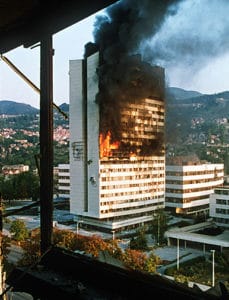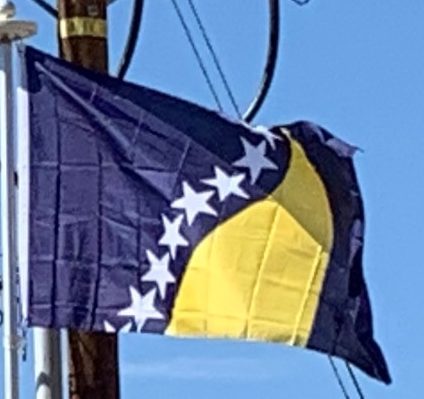The Serb members of parliament, consisting mainly of the Serb Democratic Party members, abandoned the central parliament in Sarajevo, and formed the Assembly of the Serb People of Bosnia and Herzegovina on 24 October 1991, which marked the end of the tri-ethnic coalition that governed after the elections in 1990. This Assembly established the Serbian Republic of Bosnia and Herzegovina on 9 January 1992, which was renamed Republika Srpska in August 1992. On 18 November 1991, the party branch in Bosnia and Herzegovina of the ruling party in the Republic of Croatia, the Croatian Democratic Union (HDZ), proclaimed the existence of the Croatian Community of Herzeg-Bosnia, with the Croatian Defence Council (HVO) as its military branch. It went unrecognized by the Government of Bosnia and Herzegovina, which declared it illegal.

A declaration of the sovereignty of Bosnia and Herzegovina on 15 October 1991 was followed by a referendum for independence on 29 February/1 March 1992, which was boycotted by the great majority of Serbs. The turnout in the independence referendum was 63.4 percent and 99.7 percent of voters voted for independence. Bosnia and Herzegovina declared independence on 3 March 1992 and received international recognition the following month on 6 April 1992. The Republic of Bosnia and Herzegovina was subsequently admitted as a member state of the United Nations on 22 May 1992. Serbian leader Slobodan Milošević and Croatian leader Franjo Tuđman are believed to have agreed on a partition of Bosnia and Herzegovina in March 1991, with the aim of establishing Greater Serbia and Greater Croatia.
Following Bosnia and Herzegovina’s declaration of independence, Bosnian Serb militias mobilized in different parts of the country. Government forces were poorly equipped and unprepared for the war. International recognition of Bosnia and Herzegovina increased diplomatic pressure for the Yugoslav People’s Army (JNA) to withdraw from the republic’s territory, which they officially did in June 1992. The Bosnian Serb members of the JNA simply changed insignia, formed the Army of Republika Srpska (VRS), and continued fighting. Armed and equipped from JNA stockpiles in Bosnia, supported by volunteers and various paramilitary forces from Serbia, and receiving extensive humanitarian, logistical and financial support from the Federal Republic of Yugoslavia, Republika Srpska’s offensives in 1992 managed to place much of the country under its control. The Bosnian Serb advance was accompanied by the ethnic cleansing of Bosniaks and Bosnian Croats from VRS-controlled areas. Dozens of concentration camps were established in which inmates were subjected to violence and abuse, including rape. The ethnic cleansing culminated in the Srebrenica massacre of more than 8,000 Bosniak men and boys in July 1995, which was ruled to have been a genocide by the ICTY. Bosniak and Bosnian Croat forces also committed war crimes against civilians from different ethnic groups, though on a smaller scale. Most of the Bosniak and Croat atrocities were committed during the Bosniak-Croat war, a sub-conflict of the Bosnian War that pitted the ARBiH against the HVO. The Bosniak-Croat conflict ended in March 1994, with the signing of the Washington Agreement, leading to the creation of a joint Bosniak-Croat Federation of Bosnia and Herzegovina, which amalgamated HVO-held territory with that held by the ARBiH.
Bosnia and Herzegovina After the Dayton Agreement:
Following the Srebrenica massacre, NATO launched a bombing campaign against Republika Srpska in August 1995. The bombing, together with a joint HV/HVO/ARBiH ground offensive in western Bosnia, convinced the Bosnian Serb leadership to consider a negotiated settlement, which manifested itself in the Dayton Agreement of December 1995. It brought an end to active combat and roughly established the basic political structure of the present-day state. A NATO-led peacekeeping force was immediately dispatched to the country to enforce the agreement. An estimated 100,000 people were killed in the war, about two-thirds of whom were Bosniak. An additional 2.2 million citizens of Bosnia and Herzegovina of all ethnicities were displaced. The International Criminal Tribunal for the former Yugoslavia (ICTY) has ruled the conflict involved the Federal Republic of Yugoslavia (subsequently Serbia and Montenegro), as well as Croatia. Dozens of Bosnian Serb officials and soldiers have been convicted for their role in war crimes and crimes against humanity during the conflict, as well as for the genocide in Srebrenica. Several high-ranking Croat and Bosniak officials have also been convicted. Victims’ remains continue to be unearthed. After the war, the Government of Bosnia and Herzegovina brought a lawsuit against Serbia before the International Court of Justice (ICJ), accusing the country of genocide. In 2007, the ICJ exonerated Serbia of direct responsibility for the genocide committed by Bosnian Serb forces in Srebrenica, but concluded the country had not done enough to prevent the massacre.
